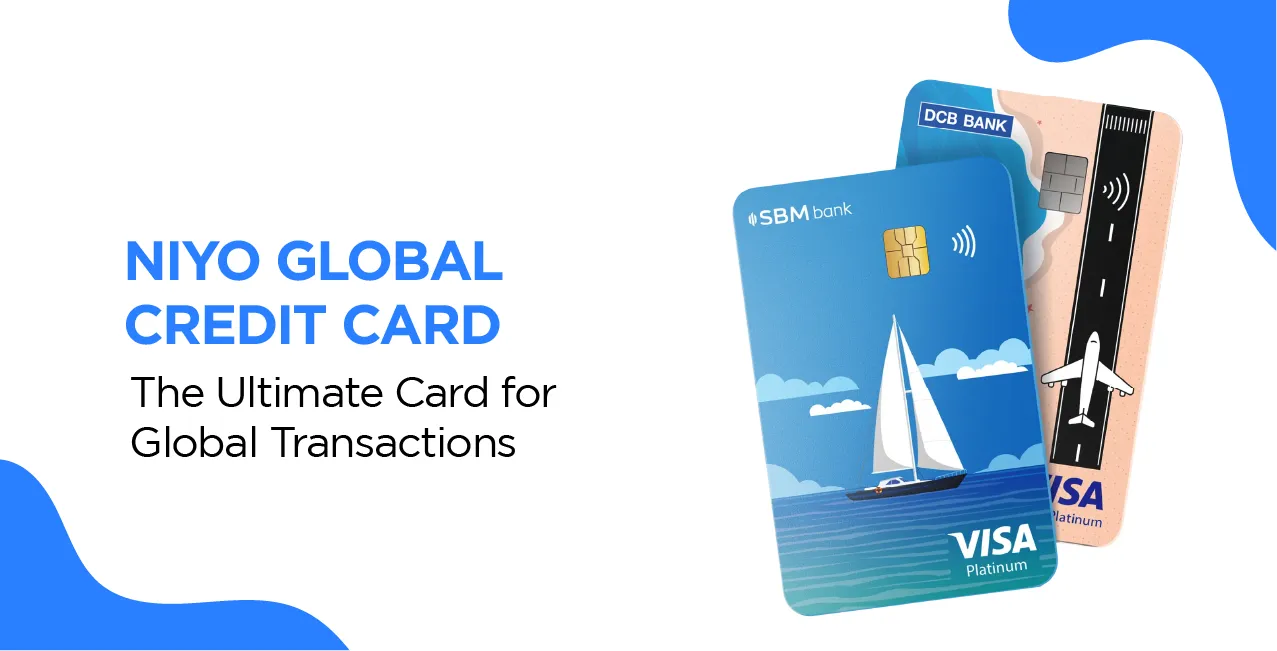
Author
LoansJagat Team
Read Time
13 Min
31 Mar 2025
Niyo Global Credit Card – The Ultimate Card for Global Transactions
Amit, a frequent traveler, often pays high foreign exchange fees while using his regular credit card abroad. On his last European trip, he spent $2,000 on hotels, dining, and shopping. His old card charged a 3% forex markup, costing him an extra $60. However, he saved this amount entirely after switching to the Niyo Global Credit Card, which offers zero forex markup.
Additionally, since he spends around ₹50,000 per month on domestic expenses, he now earns ₹500 cashback monthly, up to ₹6,000 per year. Amit also enjoys two free domestic lounge accesses per quarter, saving approximately ₹2,000 annually. This shift has reduced his travel expenses and enhanced his overall financial benefits.
This guide will help you understand more about the Niyo Global Credit Card, including its zero forex charges, rewards, fees, eligibility, and tips to maximise savings on international spending.
What is the Niyo Global Credit Card?
Read More – Best Zero Forex Markup Credit Cards
The Niyo Global Credit Card is a unique international credit card designed for individuals who frequently travel or transact in foreign currencies. Offered by the SBM Bank and powered by Visa, the card provides zero forex markup, up to 6.5% interest on savings, and features like a global ATM locator and real-time currency exchange data, all accessible through the Niyo app.
Key Features of Niyo Global Credit Card
Feature | Description |
Credit Card Network | Visas are accepted worldwide in over 200 countries. Example: How Visa Network Works with Niyo Global Credit Card
At her Paris hotel, she pays €500, which is converted to INR using Visa’s exchange rate. She buys coffee for €5, and her transaction is instantly approved. At Charles de Gaulle Airport, she made a $100 duty-free purchase, which was again processed smoothly without additional forex markup. Key Takeaway: Since Visa is accepted in over 200 countries, the Niyo Global Credit Card ensures seamless transactions worldwide, making it ideal for international travellers. |
Issuing Bank | SBM Bank India |
Minimum Fixed Deposit Requirement | ₹5,000, which determines the credit limit. Example: How the Fixed Deposit (FD) Determines the Credit Limit Your credit limit is equal to your Fixed Deposit (FD) amount. Example: Rahul opens an FD of ₹5,000, which means his credit limit is ₹5,000. Later, he increases his FD to ₹50,00, meaning his credit limit increases to ₹50,000. Priya initially deposits ₹1,00,000 for a high credit limit but later reduces her FD to ₹25,000, meaning her credit limit adjusts to ₹25,000. This system gives users complete control over their credit limit while earning interest on their FD! |
Interest-Free Period | Up to 45 days, provided previous dues are cleared. Example: How the 45-Day Interest-Free Period Works?
Since Amit made his purchase on March 5, his interest-free period extended until April 10 (36 days). If he had purchased on March 25, his interest-free period would be shorter, only 16 days (until April 10). No interest is charged if Amit pays the entire ₹10,000 by April 10. If he only pays ₹5000, the remaining ₹5000 will attract 3% monthly interest (42.58% annually). Key Takeaway: |
Grace Period for Bill Payment | An additional 3 days after the due date to make payments. Example: How the 3-Day Grace Period for Bill Payment Works
Since Niyo offers a 3-day grace period, she still has until July 13 to pay without incurring a late fee. If she pays ₹20,000 by July 13, she avoids penalties. If she pays on July 14 or later, a ₹150 late fee and 3% monthly interest (42.58% annually) will be applied to the unpaid amount. Key Takeaway:
|
Credit Limit | Based on the Fixed Deposit (FD) amount held with SBM Bank. Example: How FD Amount Determines Credit Limit
After a month, Sahil needs a higher limit for an international trip, so he increases his FD to ₹50,000, meaning his credit limit increases to ₹50,000. Later, Sahil decides he does not need such a high limit and reduces his FD to ₹20,000, meaning his credit limit drops to ₹20,000. Key Takeaway: Your credit limit is equal to your FD amount. You can adjust your FD to increase or decrease your limit at any time, giving you complete flexibility over your spending power! |
Forex Markup Fee | Zero, ensuring the best exchange rates with Visa. Example: How Zero Forex Markup Works
If the Visa exchange rate is ₹83 per USD, Rohan pays ₹83,000. A regular credit card with a 3.5% forex markup would have charged him ₹85,905 (₹83,000 + ₹2,905 markup fee). Savings with Niyo Global Card: ₹2,905 Key Takeaway: |
Lounge access | The Niyo Global credit card offers one complimentary Lounge Pass per quarter when you spend ₹50,000 outside India using a single card. You can use the Lounge Pass at over 1,300 international airport lounges. Example: How Lounge Access Works
Since she met the spending requirement, she received one complimentary Lounge Pass for the quarter. She uses the Lounge Pass at Heathrow Airport, enjoying free WiFi, comfortable seating, and complimentary food & beverages before her flight. If Sneha spends another ₹50,000 internationally in the next quarter, she will earn another Lounge Pass. Key Takeaway: For every ₹50,000 spent abroad per quarter, you earn one complimentary Lounge Pass, valid at 1,300+ international airport lounges worldwide! |
ATM Withdrawal Limit | Based on the available credit limit and subject to fees. Example: How ATM Withdrawal Limit Works
Since ATM withdrawals are subject to fees, he is charged ₹423 + 18% GST (₹75.14) = ₹498.14. His available credit limit reduces to ₹80,000 after the withdrawal. If Arjun withdraws ₹50,000 more, his credit limit is further reduced to ₹30,000. Key Takeaway: ATM withdrawals reduce your available credit limit and incur additional fees. Using the card for purchases instead of cash withdrawals, it is best to avoid extra charges. |
Billing Cycle | Monthly statements sent via email and available on the Niyo App |
Digital Access | Manage transactions, track spending, and pay bills via the Niyo App |
Eligibility Criteria for Niyo Global Credit Card
To apply for the Niyo Global Credit Card, applicants must meet the following criteria:
- Age Requirement: Must be at least 18 years old.
- Residency: Available to Indian residents only.
- Fixed Deposit (FD) Requirement: A minimum Fixed Deposit (FD) of ₹5,000 with SBM Bank India is required.
- KYC Compliance: Applicants must complete Know Your Customer (KYC) verification, which includes identity proof, address proof, and PAN card details.
- Niyo Account Requirement: Applicants must have a Niyo Global account to manage their credit card and transactions.
How to Apply for the Niyo Global Credit Card?
Applying for the Niyo Global Credit Card is a straightforward process. Follow these steps:
- Download the Niyo app, which is available on both Android and iOS.
- Sign Up & Complete KYC: Provide necessary documents, including Aadhaar, PAN, and proof of address.
- Open a Fixed Deposit (FD) with SBM Bank India: A minimum FD of ₹5,000 is required.
- Receive Your Virtual Credit Card: Once approved, a virtual credit card is issued instantly via the Niyo App. If needed, a physical card can be requested.
- Start Using for International Transactions! The card is activated and ready for global spending.
Fees & Charges of Niyo Global Credit Card
Fee Type | Amount & Description |
Joining fee/Annual fee | NIL |
Cash Advance Fee (ATM Withdrawals, Domestic & International) | ₹423 + GST or 2.5% of the amount withdrawn, whichever is higher. Example: How Cash Advance Fees Work for ATM Withdrawals
2.5% of ₹10,000 = ₹250 Fixed fee of ₹423 + 18% GST (₹76.14) = ₹499.14 Since ₹499.14 (fixed fee) is higher than ₹250 (2.5%), he is charged ₹499.14. If he had withdrawn ₹30,000, the 2.5% fee would be ₹750, which is higher than ₹499.14, so he would pay ₹750 instead. Key Takeaway: The higher of ₹423 + GST or 2.5% of the amount withdrawn applies. To minimise extra charges, avoid frequent ATM withdrawals. |
Late Payment Fee | ₹150, charged if the Minimum Amount Due (MAD) is not paid on time. Example: How Late Payment Fees Work
Since she missed the due date and the 3-day grace period (until August 8), a late payment fee of ₹150 is applied. Additionally, her remaining balance of ₹15,000 will start accruing 3% monthly interest (42.58% annually). If she had paid at least the Minimum Amount Due (MAD) of ₹750 (5% of ₹15,000) before August 8, she would have avoided the late fee. Key Takeaway: Always pay at least the Minimum Amount Due (MAD) before the grace period ends to avoid late fees and high interest charges! |
Interest Rate on Outstanding Balance | 3% per month (42.58% annually), applied to unpaid amounts. Example: How Interest in Outstanding Balance Works
Since she did not clear the full amount, interest is charged at 3% monthly. Interest on ₹15,000 = ₹450 (3% of ₹15,000). In August, her outstanding balance becomes ₹15,450 (₹15,000 + ₹450 interest). If she does not pay in August, the next month’s interest will be calculated at ₹15,450, leading to compound charges. Key Takeaway: Always pay the full amount to avoid high interest charges as unpaid balances proliferate due to compounding! |
Minimum Amount Due (MAD) | 5% of the total due (minimum ₹100) is necessary to keep the account active. Example: How Minimum Amount Due (MAD) Works
If Ravi pays ₹1,000 by September 10, he avoids the ₹150 late payment fee, but the remaining ₹19,000 will incur 3% monthly interest. If he only pays on September 15, he incurs a ₹150 late fee, and interest is charged on the entire ₹20,000. If he pays the entire ₹20,000 by September 10, he avoids all fees and interest. Key Takeaway: Paying at least the MAD keeps the account active but leads to interest charges on the remaining balance. Always aim to pay in full to avoid extra costs! |
Over Limit Fee | ₹150, charged when spending exceeds the credit limit. Example: How the Over Limit Fee Works
Since he crossed his credit limit, a ₹150 over-limit fee is applied. His new outstanding balance becomes ₹51,650 (₹51,500 + ₹150 Over Limit Fee). If he continues to exceed his limit in future transactions, he will be charged ₹150 each time. Key Takeaway: Always track your spending to stay within your credit limit and avoid the ₹150 Over Limit Fee! |
Card Issuance Fee | Nil, making it a cost-effective option |
Card Re-issuance Fee | ₹249, applicable if the card is lost or damaged. Example: How Card Re-Issuance Fee Works
The bank charges her a ₹249 re-issuance fee for the new card. The new card is dispatched and reaches her within 7-10 business days. If she had damaged her card instead, the same ₹249 fee would apply for a replacement. Key Takeaway: If your card is lost or damaged, you can request a new one by paying ₹249. Always keep your card safe to avoid unnecessary replacement charges! |
Pros & Cons of Niyo Global Credit Card
Pros | Cons |
Zero forex markup, making international transactions cheaper | ATM withdrawal charges apply, making cash withdrawals expensive |
Up to 45 days of interest-free credit, providing flexibility | Late payment fees and high interest rates for overdue amounts |
Credit limits can be increased via Fixed Deposits, giving more control to users | Requires a Fixed Deposit (FD) for issuance, unlike unsecured credit cards |
Easy digital application via Niyo App, making it user-friendly | Limited physical banking support, as most operations are app-based |
Lower fees compared to traditional credit cards, saving costs | A minimum FD of ₹5,000 is required, which might not suit all users |
Key takeaway:
The Niyo Global Credit Card offers a cost-effective solution for international spending with zero forex markup, flexible credit, and easy digital access. However, users should consider the ATM withdrawal charges, FD requirements, and limited physical banking support before applying.
Also Read - RBL Bank World Safari Credit Card
Who Should Get This Card?
- Frequent travelers who want to avoid forex fees.
- Digital-savvy users who prefer managing finances via an app.
- Students studying abroad who need a cost-effective credit option.
- Freelancers & business professionals dealing with international clients.
For those who meet these criteria and can manage their finances responsibly, the Niyo Global Credit Card is a game-changer that offers exceptional benefits with minimal costs.
Apply Now: Niyo Global Credit Card Application
For customer support, contact Niyo Global at global@goniyo.com or call 1800-103-3817.
Conclusion
The Niyo Global Credit Card is an excellent financial tool for individuals who frequently travel abroad or engage in international transactions. It offers unmatched flexibility and cost-saving advantages with zero forex markup, a generous interest-free period, and the ability to increase credit limits via fixed deposits. Its seamless digital interface also allows users to track spending, pay bills, and manage transactions effortlessly via the Niyo App.
However, users must be mindful of ATM withdrawal fees, late payment charges, and the requirement to maintain an FD. While the card is an excellent choice for those who can clear dues on time, it might not be ideal for individuals who frequently revolve their credit balance.
Frequently Asked Questions (FAQs)
1. Is the Niyo Global Credit Card available for non-resident Indians (NRIs)?
No, the card is currently only available for Indian residents. NRIs are not eligible to apply at this time.
2. How can I increase my credit limit?
Your credit limit is linked to the Fixed Deposit (FD) amount you hold with SBM Bank India. To increase your credit limit, you can open a higher FD, which will automatically reflect as an increased credit limit.
3. What happens if I only pay the Minimum Amount Due (MAD)?
If you pay only the Minimum Amount Due (MAD), the remaining balance will attract an interest rate of 3% per month (42.58% annually), which can accumulate quickly. It is recommended to pay the full outstanding balance whenever possible to avoid interest charges.
4. Can I use the Niyo Global Credit Card for domestic transactions in India?
Yes, the Niyo Global Credit Card can be used for domestic transactions within India, just like any other Visa credit card. However, its primary advantage is the zero forex markup on international transactions.
Other Credit Cards | ||||
About the Author

LoansJagat Team
‘Simplify Finance for Everyone.’ This is the common goal of our team, as we try to explain any topic with relatable examples. From personal to business finance, managing EMIs to becoming debt-free, we do extensive research on each and every parameter, so you don’t have to. Scroll up and have a look at what 15+ years of experience in the BFSI sector looks like.

Quick Apply Loan
Subscribe Now
Related Blog Post


